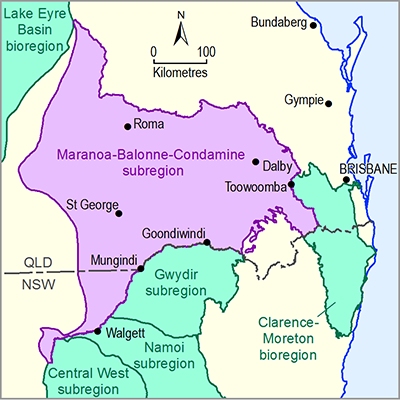Once assets were compiled into the asset database and checked for inclusion in the PAE, they were assessed for water dependence. While most assets are clearly 'water dependent' (e.g. groundwater bores, rivers and wetlands), there are a number of assets that could be affected but are not as readily identified as being 'water dependent'. Examples of these assets include historical buildings that may be potentially subject to inundation or salinity impacts, or Indigenous sociocultural water-dependent assets that may be more difficult to access.
The water dependency of threatened species habitats, including threatened ecological communities and species listed under the Commonwealth’s Environment and Biodiversity Conservation Act 1999 (EPBC Act) and species and regional ecosystems listed under Queensland’s Nature Conservation Act 1992 (Nature Conservation Act) was assessed by a review of the habitat requirements for each species. It is important to emphasise that BAs consider the potential impact to the habitat of species not the individual species per se. However, it is necessary to present species-based information to best reflect the available data, but implicit in this is the focus on habitat. In most cases, profiles from the Species Profile and Threats Database (SPRAT) (Department of the Environment, 2012; Bioregional Assessment Programme, Dataset 10), the Queensland Government’s WetlandInfo website (Department of Environment and Heritage Protection, 2015) or Queensland’s Department of Environment and Heritage Protection Regional Ecosystem Description Database (Queensland Herbarium, 2014; Department of Science, Information Technology, Innovation and the Arts, Dataset 13) were examined. The paucity of detailed descriptions of regional ecosystems listed under the Nature Conservation Act required additional spatial information for determining their water dependence. This was done by spatially intersecting the regional ecosystems’ habitat with the groundwater-dependent ecosystems’ (GDE) habitat derived from the National atlas of groundwater dependent ecosystems (Bureau of Meteorology, 2012; Bureau of Meteorology, Dataset 6). Only those GDEs (including those that rely on both surface and subsurface expression of groundwater) derived from previous field work or possessing a high or moderate potential for groundwater dependency were used in this analysis (Bureau of Meteorology, Dataset 6). If the spatial overlap of the habitat with the GDE was less than 10 % and there was no additional evidence for water dependency of the habitat the asset was not included in the asset register. The water dependence of each species-related asset was ranked as being ‘likely’, ‘possible’, ‘unlikely’ or ‘unsure’. Assets listed as ‘likely’ are those with a clear and demonstrated link to aquatic ecosystems (e.g. aquatic species). Assets listed as ‘possible’ may have some overlap with habitats that may be water dependent (e.g. species that may visit riparian areas). Assets listed as ‘unlikely’ show no evidence of surface water or groundwater dependence in habitat requirements. Where assets were recorded as ‘unsure’, the precautionary principle was applied and the asset retained for inclusion in the water-dependent asset register.
Assets classed as ‘Surface water features’ or ‘Groundwater features’, or assets with names that include the terms waterhole, lake, lagoon, soak, etc., were assumed to be water dependent. Similarly, assets sourced from the National atlas of groundwater dependent ecosystems (Bureau of Meteorology, 2012; Bureau of Meteorology, Dataset 6) with a known groundwater dependency (derived from previous field work or possessing a high or moderate potential for groundwater dependency) were assumed to be water dependent (attributed as ‘likely’). Assets with a moderate potential for groundwater dependency were attributed as ‘possible’ and also included in the register. Where assets were identified as having a low probability for groundwater dependence, it was assumed that these assets were unlikely to be groundwater dependent and were not included in the water-dependent asset register. The mapping of GDEs done by the Queensland Government (DSITIA, 2012) used more extensive data sources and validation than the National atlas of groundwater dependent ecosystems, thus all groundwater-dependent ecosystem assets provided from the Queensland Government (Queensland Department of Science, Information Technology, Innovation and the Arts, Dataset 16) are included in the water-dependent asset register.
For many assets, water dependency is not obvious, such as national parks, nature reserves or historical buildings. Therefore, a preliminary assessment of the water dependency was made using multiple lines of evidence. Water-dependent assets were those that met at least one or more of the following criteria:
- intersected with existing Queensland floodplain mapping (Geoscience Australia, Dataset 31; Office of Environment and Heritage, Department of Premier and Cabinet, Dataset 32)
- contained wetlands or other surface water features identified in existing Queensland wetland mapping (Queensland Department of Environment and Heritage Protection, Dataset 33; NSW Department of Environment, Climate Change and Water, Dataset 34; Department of Sustainability, Environment, Water, Population and Communities, Dataset 35)
- occurred over shallow groundwater, where shallow groundwater is defined as regions where depth to groundwater is less than 10 m (Geoscience Australia, Dataset 36)
- occurred in regions where depth to groundwater ranged between 10 to 20 m. This second criterion considered those assets that may access groundwater intermittently (Geoscience Australia, Dataset 36)
- contained water-dependent assets already listed in the water-dependent asset register.
Each of these criteria were assessed by inspecting assets against the existing data sources. In some cases, assets extended beyond the boundary of the PAE. If assets intersected with floodplains, wetlands or the depth-to-groundwater criteria outside of the PAE, then this was noted and these assets were deemed not to be water dependent for the purposes of the BA. Assets attributed as ‘likely’ or ‘possible’ were included in the BA and flagged as ‘On’ with respect to water dependency in the asset database. Assets attributed as ‘unlikely’ were flagged as ‘Off’ in the asset database and are not included in the preliminary water-dependent asset register.

